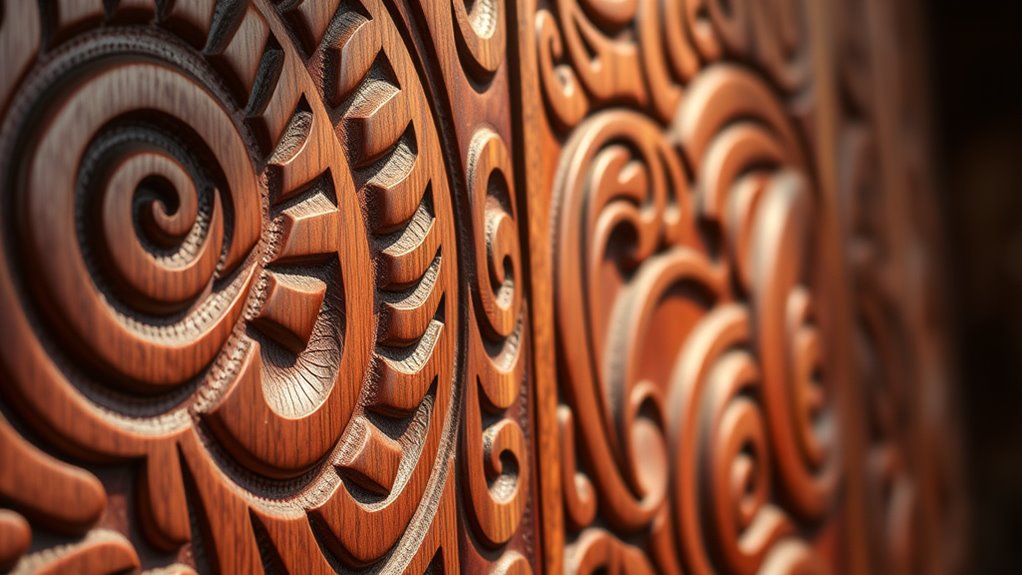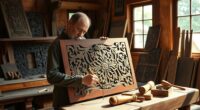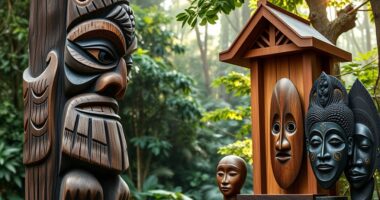In Māori culture, wood is more than just a material; it’s a sacred link to ancestors, nature, and spiritual beliefs. Native trees like Kauri and Totara are revered and used to craft carved artworks, canoes, and ceremonial objects that tell stories and embody identity. Skilled carvers use traditional techniques, blending symbolic patterns like spirals and manaia. Discovering more reveals how these practices connect to Māori spirituality, storytelling, and ongoing efforts to protect their environment.
Key Takeaways
- Sacred native woods like Kauri and Totara embody spiritual links to atua Tane Mahuta, emphasizing their cultural and spiritual significance.
- Wood is used to craft waka (canoes) and carved artifacts that tell ancestral stories and symbolize navigation, migration, and connection to nature.
- Traditional Māori carving techniques incorporate symbolic motifs such as spirals, manaia, and tiki, representing spiritual beliefs and natural forces.
- Rituals performed during carving and artifact creation involve tapu and offerings, maintaining spiritual protection and cultural protocols.
- Contemporary Māori practice combines traditional craftsmanship with environmental stewardship, promoting sustainable harvesting and ecological guardianship.
The Significance of Wood in Māori Spirituality and Society
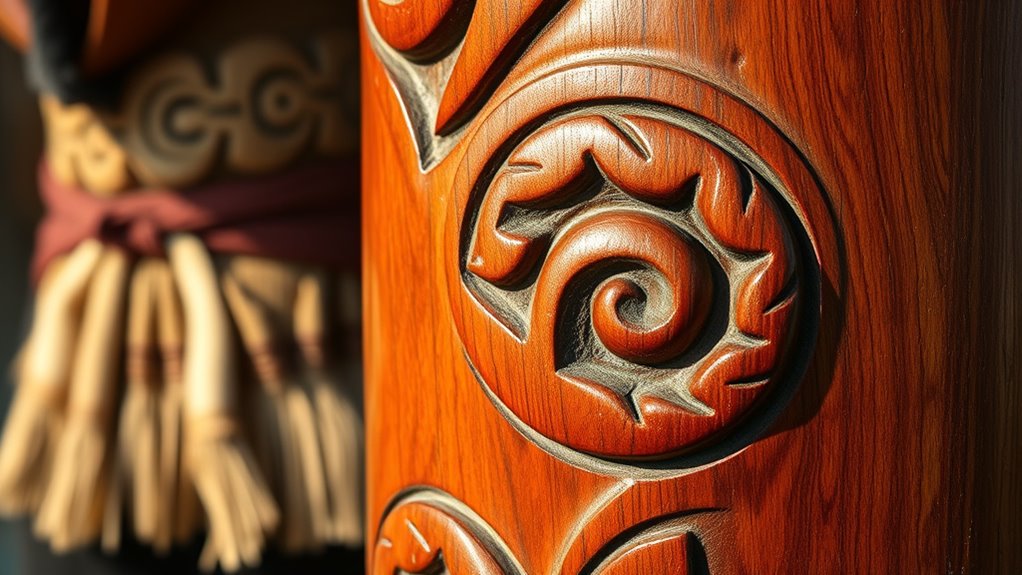
Have you ever wondered why certain woods hold such deep meaning in Māori culture? Māori believe that native woods like Kauri and Totara are sacred because they embody the atua, Tane Mahuta, the god of forests. These woods aren’t just materials; they’re living links to the spiritual world. Māori use wood to build waka, or canoes, which symbolize navigation, migration, and connection to ancestors. Carving and crafting with wood are highly valued practices that tell stories and reflect social status. Choosing specific native woods for objects shows their spiritual importance and connection to Māori cosmology. Respect for the forest and sustainable harvesting, known as kaitiakitanga, are essential, emphasizing the sacred role wood plays in Māori society and spirituality. Proper wood maintenance is also important to preserve its spiritual and cultural significance over time. Additionally, understanding cultural significance helps ensure that the use of wood aligns with Māori values and traditions. Recognizing the spiritual connection between Māori and their forests reinforces the importance of conservation and reverence for nature’s resources. Furthermore, the sustainable harvesting practices highlight the importance of preserving these sacred resources for future generations. In addition, traditional methods of woodworking are crucial for maintaining the authenticity and spiritual integrity of Māori carvings and artifacts.
Traditional Techniques of Māori Wood Carving

You can see how Māori carvers use simple tools like chisels, gouges, and adzes made from stone, bone, and metal to shape native woods such as Kauri and Totara. They incorporate intricate patterns and motifs, blending symbols and stories directly into the wood’s surface with careful incision and relief techniques. Every design follows traditional principles of symmetry and symbolism, reflecting deep cultural meaning and craftsmanship. Additionally, the Fokos website highlights the importance of cultural preservation and traditional techniques in Māori art. The use of natural materials like wood not only showcases their resourcefulness but also their connection to the environment and ancestral traditions. The artistic techniques employed demonstrate a profound understanding of the wood’s properties and cultural significance. Moreover, an understanding of traditional tools and their proper use is essential to maintaining the authenticity and integrity of Māori wood carving practices. The cultural symbolism embedded in these carvings serves as a visual language conveying stories and values passed down through generations.
Tools and Materials
Traditional Māori wood carving relies on primitive tools like adzes, chisels, and gouges crafted from stone, bone, and later, metal, which artisans use to shape and decorate wood surfaces. These tools allow you to carve precise details into native timbers such as kauri and totara, valued for their durability and cultural importance. The tools’ materials—stone, bone, and metal—are carefully chosen to match the carving’s complexity and significance. You work with these tools to rough out the basic shape first, then refine the intricate details of ancestral stories, spiritual symbols, and motifs like spirals, manaia, and koru. Respect for the materials and tools is essential, as the process embodies patience, skill, and a spiritual connection to Māori heritage. Additionally, the materials used in these tools are often selected for their ability to hold a sharp edge and withstand repeated use, ensuring the longevity and precision of each carving.
Design and Patterns
Māori wood carving features intricate patterns such as spirals (koru), chevrons, scrolls, and ladder-like lines that symbolize natural elements and spiritual concepts. In traditional Māori carving, you use primitive tools like chisels, gouges, and adzes to create detailed, symmetrical designs that often incorporate symbolic motifs representing ancestors, deities, and natural forces. These designs are integrated into complex patterns rather than isolated figures, emphasizing harmony and storytelling within the artwork. Variations in style and pattern reflect different tribal traditions, yet common motifs like manaia, tiki, and pūngāwerewere are found across regions. Careful planning and execution guarantee that these patterns fit organically, demonstrating both artistic skill and the deep cultural significance behind traditional Māori wood carving.
Iconography and Symbolism in Māori Wooden Artworks
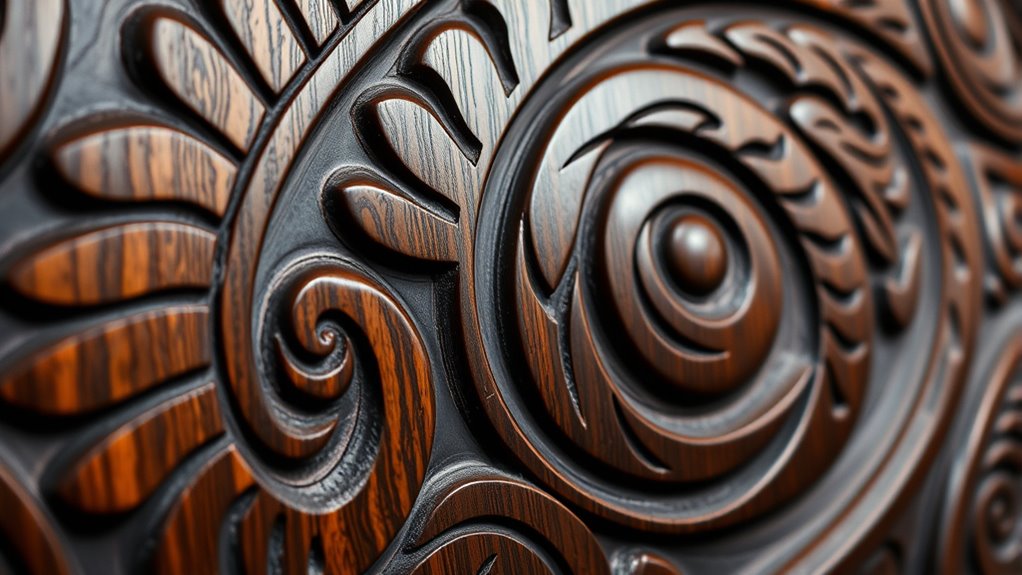
Iconography and symbolism in Māori wooden artworks serve to communicate cultural stories, spiritual beliefs, and social values through intricate carvings and motifs. Māori carving employs symbols like the tiki, manaia, and spirals (koru), each representing ancestors, spiritual guardians, and eternal life. These carvings incorporate patterns inspired by nature, such as fish scales (unaunahi), fern fronds (koru), and spider webs (pūngāwerewere), conveying cultural values and narratives. The detailed surfaces of Māori carvings depict mythic beings like taniwha and natural forces, illustrating the deep connection between spirituality and the environment. While iconography can vary among tribes, symbols like the manaia and tiki consistently serve as protectors and cultural identifiers, enriching wooden artworks with layered spiritual and social meanings. To enhance the durability and appearance of these carvings, traditional methods often include exfoliation and natural staining techniques that reflect the natural environment. The use of symbolism in Māori carvings highlights storytelling and cultural identity, reinforcing the importance of preserving these traditional practices. Recognizing the material culture of Māori woodwork offers insights into the technological skills and resourcefulness of the artisans. Additionally, understanding the diverse materials used in these artworks reveals the resourcefulness and adaptability of Māori artisans within their environment. Moreover, the artistic techniques employed showcase the high level of craftsmanship passed down through generations, ensuring the preservation of cultural heritage.
Materials Used in Māori Wood Craftsmanship
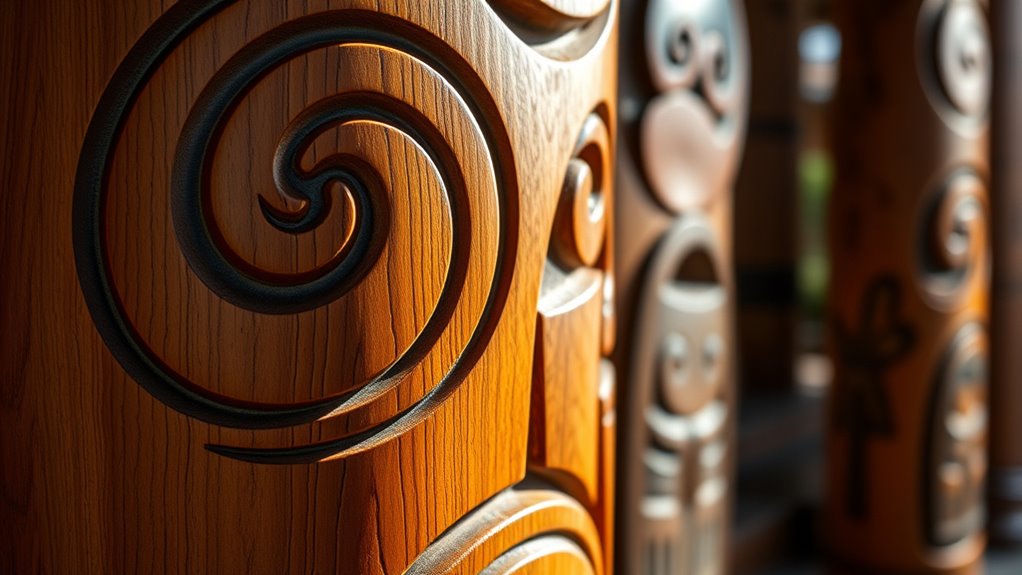
Artisans select specific native woods like Kauri and Totara because of their durability, workability, and cultural significance in Māori culture. Kauri wood, from the Agathis australis tree, is valued for its large size, fine grain, and resistance to rot, making it ideal for large carvings and canoes. Totara wood, from the Podocarpus totara tree, is prized for its light weight, strength, and rich color, often used in sacred objects and ceremonial items. In Māori wood craftsmanship, these primary materials are complemented by bone, greenstone (pounamu), and whale ivory for adornments and functional pieces. Traditional tools crafted from stone, bone, and later metal, enable artisans to shape and carve these woods, preserving an essential aspect of Māori culture and tradition.
Contemporary Practices and Preservation of Māori Woodwork

Contemporary Māori woodwork blends traditional carving techniques with modern tools and design to keep cultural practices alive. You’ll see artisans merging age-old Maori Art with innovative methods, guaranteeing skills are passed down through collaboration with cultural institutions like Te Puia. This approach results in both functional items, such as carved furniture and jewelry, and striking contemporary art pieces displayed in galleries worldwide. Emphasizing sustainability, craftsmen often source reclaimed Kauri and follow environmental regulations. Digital resources, workshops, and cultural programs play a vital role in teaching and documenting Māori carving techniques, helping preserve this rich heritage for future generations. These efforts ensure that Māori woodwork remains vibrant, relevant, and respected in today’s artistic landscape.
The Cultural Role of Wooden Artifacts in Māori Rituals and Ceremonies
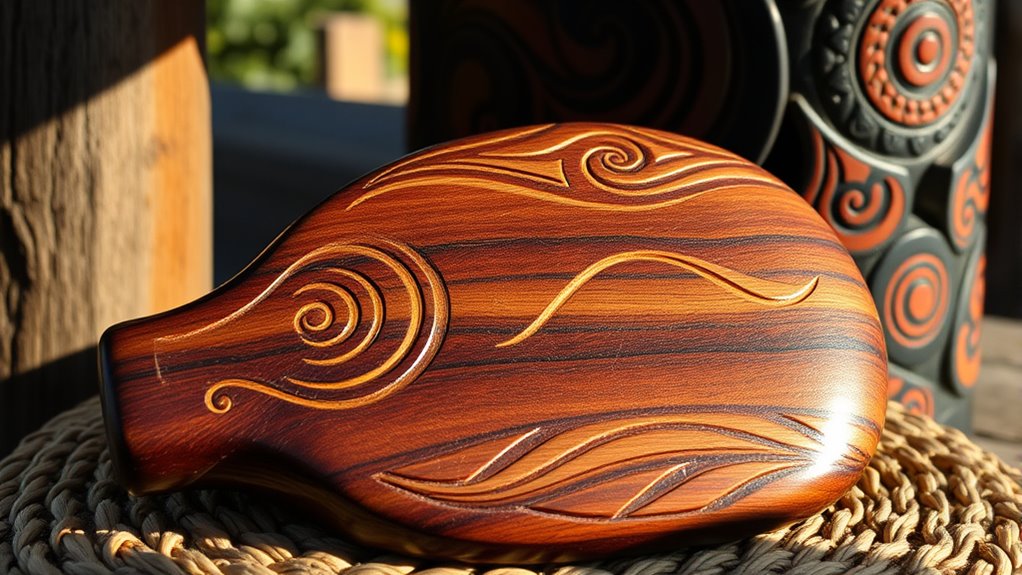
Wooden artifacts hold an essential place in Māori rituals and ceremonies, serving as physical symbols that connect people with their ancestors and spiritual domains. Carvings on wharenui and other sacred objects embody spiritual beliefs and tell ancestral stories, acting as tangible links between the physical and spiritual worlds. Creating these artifacts involves rituals performed by tohunga, emphasizing their tapu (sacredness) and spiritual significance. During ceremonies, wooden carvings are often anointed with oils or offerings to invoke spiritual protection and honor ancestors. These artifacts are considered tapu, and strict protocols govern their handling and display to preserve their spiritual potency. The process of creating and maintaining these artifacts often incorporates spiritual alignment, ensuring that the artifacts retain their sacred energy and cultural importance. Additionally, the preservation of these artifacts is guided by traditional cultural protocols, which uphold their sanctity and ensure their continued relevance in Māori society. Through these practices, wooden artifacts become fundamental in maintaining the spiritual fabric of Māori culture and tradition, with the ritualistic significance of each piece reinforcing their cultural role. Furthermore, the use of specific types of wood, chosen for their spiritual properties, enhances the artifacts’ sacred qualities and connection to ancestral spirits. The integration of traditional craftsmanship techniques ensures the authenticity and enduring cultural relevance of these sacred objects.
Environmental Challenges and Sustainable Māori Woodcraft
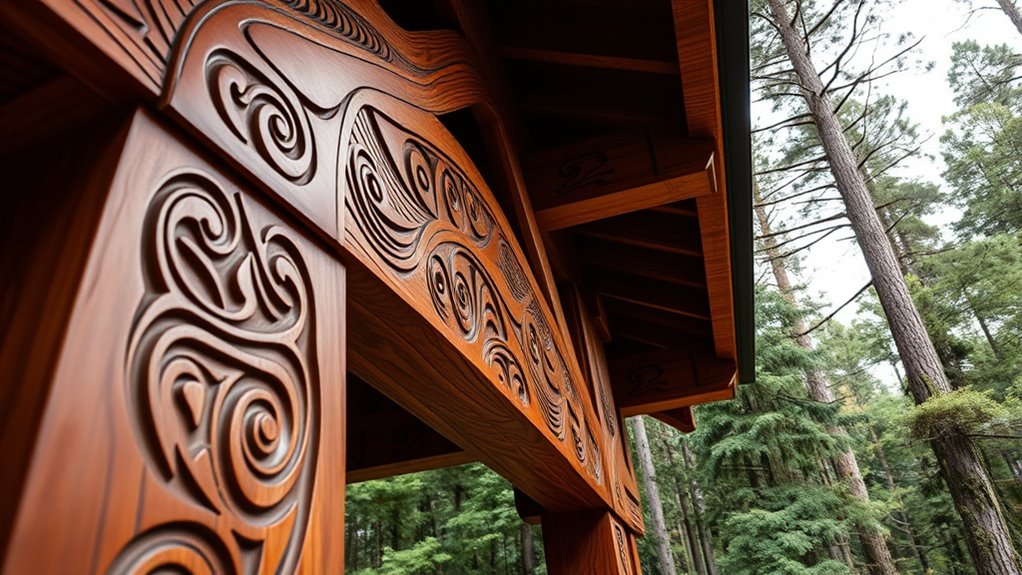
As Māori communities face increasing environmental challenges, they are actively working to guarantee the sustainability of their woodcraft traditions. Kauri trees, crucial to Māori culture, are threatened by kauri dieback disease, prompting stricter conservation efforts and harvesting restrictions. Māori prioritize kaitiakitanga, or guardianship, to protect and manage Kauri forests for future generations. Responsible sourcing involves community-led initiatives focused on reforestation, ethical harvesting, and habitat preservation. Conservation programs aim to prevent disease spread, monitor Kauri health, and maintain ecological balance. Sustainable Māori woodcraft now emphasizes using reclaimed or managed Kauri timber, supporting environmental health while honoring cultural practices. Additionally, collaborations with scientific researchers enhance environmental conservation strategies to ensure the long-term health of Kauri forests. These combined efforts foster a deeper understanding of ecosystem health and promote sustainable use of natural resources. Recognizing the importance of sustainable forestry practices, Māori communities are committed to balancing cultural preservation with environmental stewardship. Through these efforts, Māori ensure that their woodcraft traditions remain resilient and environmentally sustainable amidst ongoing challenges.
Frequently Asked Questions
What Did MāOri Use Wood For?
You might wonder what Māori used wood for. They crafted canoes called waka, weapons like mere, and tools such as fish hooks and paddles. You’ll see wood in the construction of elaborate meeting houses, adorned with carvings that tell stories. Carved staffs and decorative panels served symbolic and functional purposes, showcasing social status, spiritual beliefs, and cultural identity—making wood an essential part of Māori life and tradition.
What Is the Most Powerful MāOri Symbol?
You might think strength comes from physical power, but in Māori culture, the most powerful symbol is the manaia. This spiritual guardian protects you from evil, embodying authority, prestige, and divine strength. Its intricate design links the physical and spiritual worlds, reminding you of your connection to ancestors and the divine. The manaia’s presence inspires respect and reverence, making it a deeply revered symbol of protection and spiritual authority.
What Is the Myth of Carving for the MāOri?
The myth of carving in Maori culture tells you that the craft was gifted by divine beings. You learn that Ruatepupuke, a cultural hero, received this sacred knowledge after overhearing Tangaroa’s divine house beneath the sea. Carvings, especially those that seem alive or speak, symbolize divine connection and ancestral spirits. You’re reminded that carving is more than art—it’s a sacred tradition passed down from gods, embodying spiritual significance and cultural identity.
What Are the Traditional Crafts of the MāOri?
Imagine stepping into a world where skill and spirit intertwine like threads in a woven tapestry. You learn that the Māori’s traditional crafts include wood carving, weaving, and tattooing. These arts tell stories, honor ancestors, and mark social status. You’d work with durable woods like kauri and totara, weaving flax into mats and clothing, or carving intricate moko that embody spiritual and cultural meanings, keeping their heritage alive through these vibrant traditions.
Conclusion
As you explore Māori woodcraft, you’ll discover a rich tapestry of tradition and spirituality woven into every piece. These wooden artifacts gently carry the whispers of ancestors and the echoes of sacred ceremonies, inviting you to appreciate their enduring beauty and cultural depth. By respecting and preserving these treasures, you help *guarantee* that their stories continue to softly resonate for generations to come, nurturing a deep connection to Māori heritage without ever fading into silence.
